11 things you didn’t know about The Little Book of Confusables

Think The Little Book of Confusables is just a book about words? Think again. Here are 11 surprising reasons to buy the fun, invaluable guide to commonly confused words.
1) It’ll save you time
Mental block? Need to check which spelling you need? It’s quicker to get the answer you need using The Little Book of Confusables than Google.
Copywriter Matt Phil Carver put the book to the test and reported in his five-star review that it’s more than twice as quick as Googling.
Here’s Matt’s review…
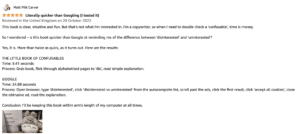
2) It’s a godsend for comms teams
Comms teams, marketing departments, small business owners… make that anyone who writes.
Clare Laxton, Director of Communications and Influencing at Pause, tweeted:
“Starting the week with The Little Book of Confusables by the brilliant @STEcopywriting. An absolute must have for all Charity Comms teams – it helps me so much with all the writing I do in my role.”
Alison Relf from Taylor Alden PR loved her copy so much she treated her team to one each:
“Have just bought five copies on Amazon for ease! Cannot wait to give them to the team for Christmas!”
Boss of the year, I’d say…
Learning English as a foreign language? The Little Book of Confusables isn’t just a fab resource for translators and interpreters – it’s great for EFL students, and teachers, too.
Canadian reader, Jacqui, describes it as:
“Brilliantly laid out and a great addition to my writing guides collection. I highly recommend it for linguists and even ESL teachers.”
While MDGB says:
“As an in-house translator, colleagues regularly ask me to cast an eye over documents. An accessible usage guide as a desktop reference is very useful particularly as people ‘mishear’ a phrase that they wish to use. There are also helpful tips to help remember which homonym to use. Useful also for native speakers encountering the onset of language depletion in their mother tongue.”
Just four months after launch, The Little Book of Confusables has sold in 18 countries around the world:
Australia, Austria, Brazil, Canada, France, Germany, India, Italy, Japan, the Netherlands, New Zealand, Portugal, South Korea, Spain, Switzerland, Tenerife, the UK and the US.
5) Language professionals swear by it
Copywriters, editors, proofreaders, translators, marketing managers, authors… you’ll find glowing five-star reviews from all of them.
Because we all have language blindspots.
Tom Albrighton, author of How To Write Clearly, says:
“Every writer – in fact, everyone who writes – needs a copy of this book on their desk. It’s comprehensive, authoritative and, most importantly, great fun to read.”
Anna Gunning, director of Gunning Marketing, says:
“This book is amazing – no matter how many years you’ve been writing and no matter how much of a grammar nerd you are. It’s a book to keep next to your computer at all times.”
6) It’s jam-packed with commonly confused words
Almost 600, to be precise.
Starting with the obvious homophones, including AFFECT/EFFECT, PRINCIPAL/PRINCIPLE, ELICIT/ILLICIT and COMPLIMENT/COMPLEMENT.
Then there are the mishearings, like DAMPSQUID, DOGGY-DOG WORLD, WHITE AS A SHEEP and OUTER-BODY EXPERIENCE.
Finally, the word pairs that get misused time and again – from ACUTE/CHRONIC and LEND/BORROW to LIBEL/SLANDER and POISONOUS/VENOMOUS.
What’s your language blindspot? And which words have you been misusing your whole life?
7) It really is little!
Despite having 300+ pages, The Little Book of Confusables is a pocket-sized, easy-to-grab paperback.
Kirsty Brooks, owner of Little Batch, calls it:
“Concise yet packed. Chunky, yet pocket-sized. The best bits of Sarah’s Instagram tips in a cute and chunky book!”
And copywriter, Cat Roberts Young, says:
“No writer, English speaker or English language learner should be without a copy of this book. All the answers, perfectly pocket-sized, in a book that will never leave your desk.”
(You can even stand it up on your desk like a paperweight, should you wish to. Win–win.)
8) It’ll make you laugh
Yes, The Little Book of Confusables is a deliciously nerdy, wordy reference book, but don’t expect it to be dull!
It’s packed full of quirky, witty wordiness that’ll make you laugh out loud while you learn.
From examples like TORTUOUS/TORTUROUS/TORTOISE/TOTORO and WARRIOR/WORRIER/WARIO (and his world-famous fictional moustache) to catchy ways to remember the spellings that catch you out Every. Single. Time.
Sophie says:
“I didn’t realise until my mid-twenties that saying ‘bare with me’ was wrong and that it’s actually ‘bear with me’. I’d been propositioning people inappropriately for years! Loving this book as my new handy sidekick to avoid similar mistakes in future, and it’s got some brilliantly funny examples too!”
And Anne says:
“The definitions are silly and memorable and I will go back to this book just to remind myself of some of the differences – venomous/poisonous, marinade/marinate… but I’ll also go back to it for a giggle. Using sci fi, computer games, rappers… Ms Townsend entertains while making a point.”
JESTER of goodwill, anyone?!
9) It’s a fab gift
The Little Book of Confusables was awarded best stocking filler in the Christmas issue of WI Life magazine.
With a circulation of 200k, that’s a lot of stockings.
Nic H says:
“My 7 year old son and I read through this book together. We not only had a lot of fun but we learned some stuff i.e. became less confused about confusing words! This is a really nice stocking filler.”
And Eriketo says:
“Can’t recommend this book highly enough. Even if you don’t think you need it, you definitely do. And get one for all of your team/family/friends too while you’re at it.”
(Someone described it as ‘the perfect toilet book’. I didn’t know whether to be flattered or insulted – but apparently, that’s a good thing. If you’re into trivia and “I did NOT know that!” moments, you’ll love it.)
10) Your kids will pinch it
One dad says:
“This cracking little book by Sarah Townsend is MAGICAL for keeping in the car. Especially on drives and school runs with the kids. A super-accessible format! It’s like having a stash of word Haribos on hand to whip out whenever the kids are getting a bit bored.”
I’m not an academic or an English graduate. Instead, I’ve 30+ years’ experience of using real-world, human language to help businesses get noticed – so The Little Book of Confusables is always accessible.
Claire Handscomb says:
“I cannot recommend this book highly enough. It should be on every desk or bookshelf and on the essential reading list in every university. However good we think we are at writing, we all need a little help with some of the idiosyncrasies of the English language!”
And input from my 19-year-old son before he headed to uni (to study English and creative writing, appropriately) means The Little Book of Confusables is down with the kids.
Or whatever the kids are saying these days.
11) It’s gorgeous
Author of The Creative Nudge, Kevin Chesters describes The Little Book of Confusables as:
“The perfect mix of aesthetic and usability! I love it. You’ll keep returning again and again.”
Copywriter Catherine Every, says:
“What a brilliant little book that I suspect will spend more time on my desk than on my bookshelf! It’s a gorgeous thing too, with a distinctive size and a fabulous typeface, so it’s just lovely to browse through.”
I’ll leave the last word to William Morris:
“Have nothing in your houses that you do not know to be useful, or believe to be beautiful.”
The Little Book of Confusables is both. You’ll wonder how you ever managed without it.
Treat yourself or your team to a copy of The Little Book of Confusables from Amazon, or get a signed copy direct from me and end the confusion in your life!
There’ll vs they’ll: simple tips to help you remember
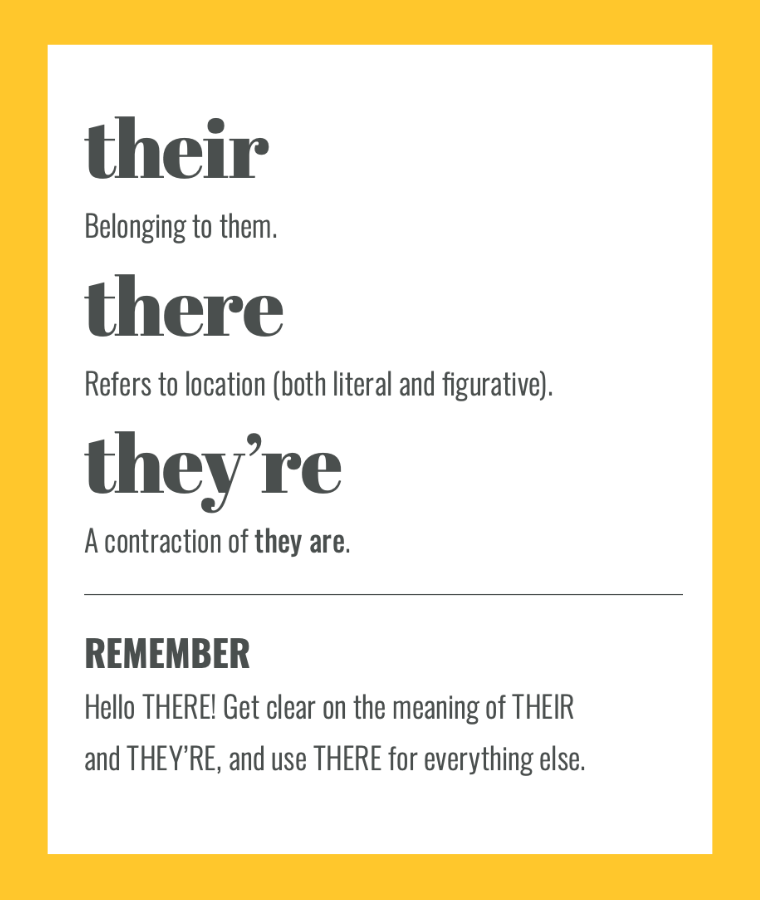
THERE’LL vs THEY’LL: which is which? Learn the difference
THERE’LL and THEY’LL are often confused but remembering the difference is easy when you know how. These simple tips will help you decide which word you need.
When to use there’ll
THERE’LL is a contraction of the words there + will = THERE’LL
The apostrophe in the word there’ll shows that there are letters missing – in this case, w and i.
Here are a couple of examples of the word there’ll used in a sentence:
“There’ll be trouble!” = “There will be trouble!”
“There’ll be blue birds over the white cliffs of Dover” = “There will be blue birds over the white cliffs of Dover”
When to use they’ll
THEY’LL is a contraction of the words they + will = they’ll.
It is the short version of:
Here’s how they’ll is used in a sentence:
“They’ll be late!” = “They will be late!”
“They’ll need a lie-in after their late night” = “They’ll need a lie-in after their late night”
In a nutshell, to remember the difference between there’ll and they’ll, start by writing the contraction in full, to see if you mean there or they.
Get more tips in The Little Book of Confusables
Bear vs bare: spelling tips to help you learn the difference
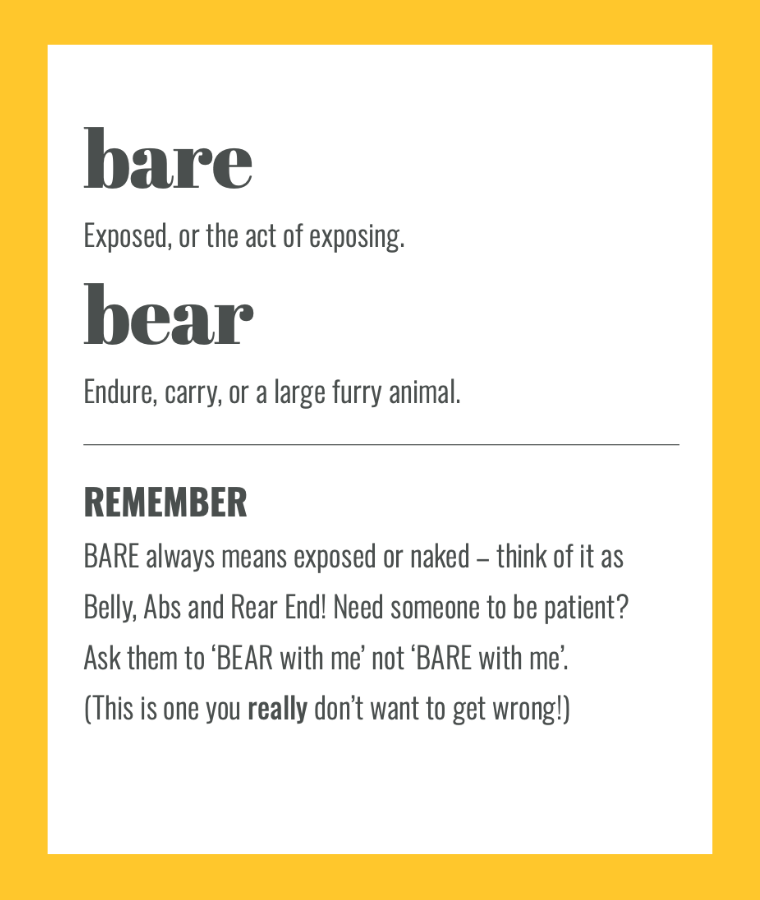
The words BEAR and BARE are easy to confuse – particularly when you’re using the expression bear with me, when there’s a world of a difference in meaning! This is one you really don’t want to get wrong!
Here are my simple tips to remember the difference between BEAR and BARE.
When to use bear
BEAR can be a noun or a verb.
As a verb, it means to carry or endure. You can use it in a sentence like this:
“Please bear with me for a moment.”
OR
“The pressure was hard to bear.”
As a noun, bear is a large animal.
For example:
“Winnie-the-Pooh is a famous bear.”
When to use bare
BARE can be a verb or an adjective.
As a verb, bare means to expose, like this:
“I will bare my soul and be completely honest.”
As an adjective, bare means exposed, like this:
“The gorilla beat his bare chest.”
Now you know the difference between bear and bare you can see that the phrases “bear with me” (please be patient) and “bare with me” (let’s get naked) should never be mixed up! I hope these tips help you to remember the difference between these commonly confused spellings in the future.
Get more tips in The Little Book of Confusables
Too vs to vs two: simple tips to help you remember
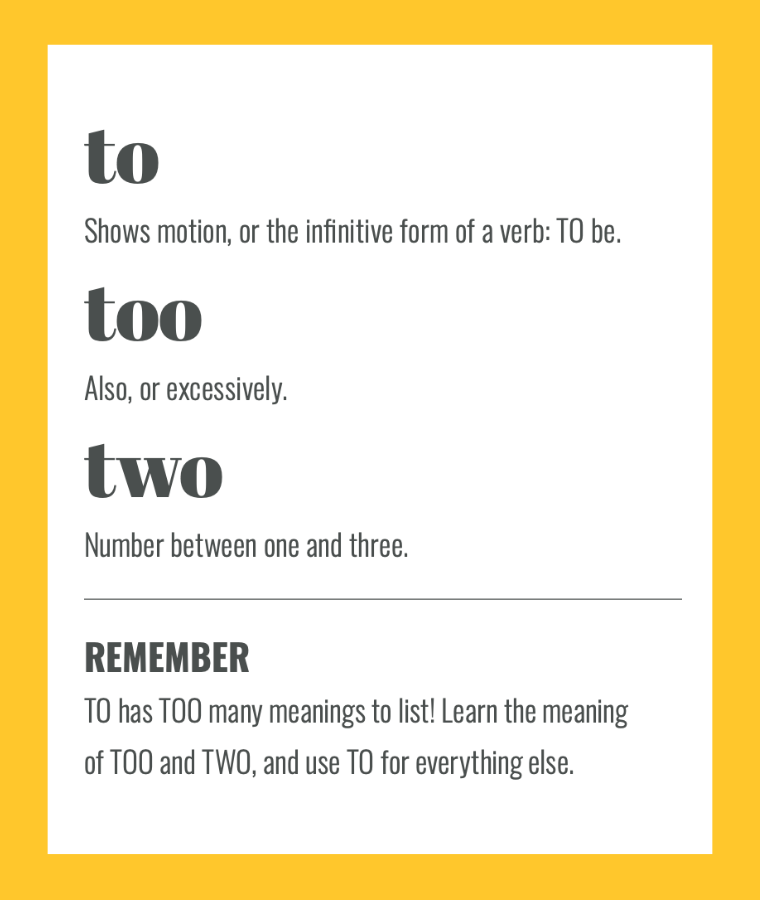
TOO vs TO vs TWO – simple tips to remember the difference
TOO, TO and TWO are easy to confuse. They may sound the same but they have different uses. These simple tips will help you decide which word you need.
When to use too
TOO is an adverb meaning as well or excessively.
For example:
“I’m going to the park too.”
OR
“I can’t go because it’s too far.”
To help you remember which spelling you need, think O + O = as + well
OR
Two Ss in exceSSive and two Os in too
When to use to
To is a useful preposition that has several meanings. It’s also the most common of the three spellings.
It can be used to indicate a direction, goal, place of arrival or a period of time.
For example:
“I’m going to the shop.”
“The shop is open from 7am to 9pm.”
To can also be used to show the infinitive form of a verb, like this:
“I’m going to buy a newspaper” = to buy
“She needs to leave soon” = to leave
When to use two
Though it’s far less likely to be confused with to and too, the spelling two is the easy one to remember, as it’s only ever the number 2 spelled out.
For example:
“The park is two miles away.”
OR
“Just the two of us.”
I hope these tips help you remember the difference between too, to and two. Feel free to share your tips if you have a different way of remembering.
Get more tips in The Little Book of Confusables
Whose vs who’s: tips to help you learn the difference
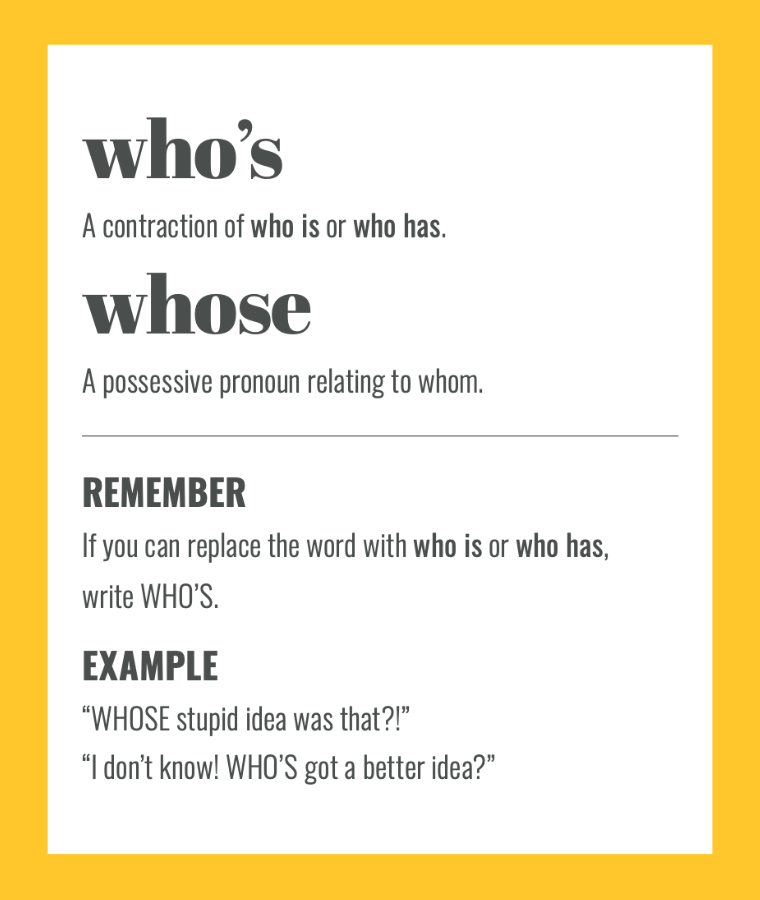
WHOSE vs WHO’S – learn the difference between these two commonly confused spellings.
WHOSE and WHO’S are easy to confuse. Though they sound the same – and both have their root in the word WHO – they have different meanings. These simple tips will help you learn the difference.
When to use whose
WHOSE is a possessive pronoun used to ask or tell whom something belongs to.
For example:
“Whose pencil is this?”
OR
“JK Rowling is an author whose books are loved by millions.”
When to use who’s
WHO’S is a contraction of who + is or who + has.
For example:
“Who’s coming with me?” = “Who is coming with me?”
OR
“Shall I see who’s gone with him?” = “Shall I see who has gone with him?”
In a nutshell, if you can replace the word you’re writing with either who is or who has, always use WHO’S.
I hope this guidance helps you remember the difference between whose and who’s. Let me know how you get on.
Want more writing tips?
For more language love, join my Clever Copy Club and get monthly updates direct to your inbox. Alternatively, email me, follow me on Twitter, connect on LinkedIn or like my page on Facebook.


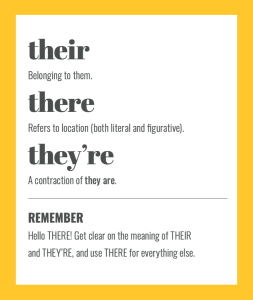
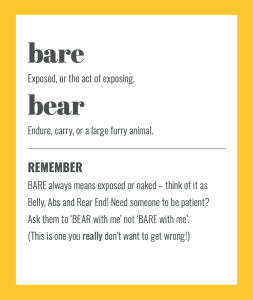
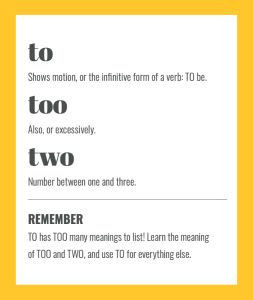
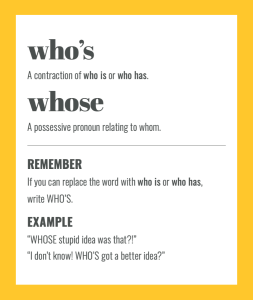
3) It’s a gold award winner!
This handy little book won GOLD in the 2023 eLit book awards, in recognition of its gorgeous design and all-round usefulness. Yay!
Tony R says:
No more asking your boss to “BARE with me”.
Yikes!
(Prefer to avoid Amazon? No worries! Treat yourself to a signed copy direct from me.)